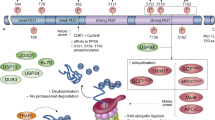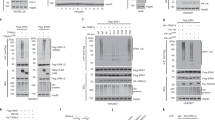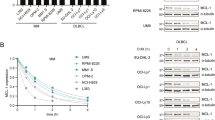Abstract
Bim is a proapoptotic member of the Bcl-2 family that shares only the BH3 domain with this family. Three Bim proteins Bim-EL, Bim-L and Bim-S are synthesized from the same transcript. We report here that Bim-EL when phosphorylated by Erk1/2 is rapidly degraded via the proteasome pathway. Using different cellular models we evidence that serine 69 is both necessary and sufficient for Erk1/2-mediated phosphorylation and degradation of Bim-EL. In K562 cells, Phorbol 12-myristate 13-acetate activates Erk1/2 and consequently increases Bim-EL phosphorylation and degradation by the proteasome, resulting in cell survival, while the Bcr-Abl inhibitor imatinib abrogates Bim-EL phosphorylation and degradation and induces caspase activation and apoptosis. We also show that Bim-EL(S69G) promotes apoptosis more efficiently than Bim-EL-WT in K562 cells. Altogether, our findings demonstrate that phosphorylation of Bim-EL by Erk1/2 on serine 69 selectively leads to its proteasomal degradation and therefore represents a new and important mechanism of Bim regulation.
This is a preview of subscription content, access via your institution
Access options
Subscribe to this journal
Receive 50 print issues and online access
$259.00 per year
only $5.18 per issue
Buy this article
- Purchase on Springer Link
- Instant access to full article PDF
Prices may be subject to local taxes which are calculated during checkout







Similar content being viewed by others
References
Bertolotto C, Maulon L, Filippa N, Baier G and Auberger P . (2000). J. Biol. Chem., 275, 37246–37250.
Biswas SC and Greene LA . (2002). J. Biol. Chem., 277, 49511–49516.
Bonni A, Brunet A, West AE, Datta SR, Takasu MA and Greenberg ME . (1999). Science, 286, 1358–1362.
Bouillet P, Metcalf D, Huang DC, Tarlinton DM, Kay TW, Kontgen F, Adams JM and Strasser A . (1999). Science, 286, 1735–1738.
Bouillet P, Purton JF, Godfrey DI, Zhang LC, Coultas L, Puthalakath H, Pellegrini M, Cory S, Adams JM and Strasser A . (2002). Nature, 415, 922–926.
Breitschopf K, Haendeler J, Malchow P, Zeiher AM and Dimmeler S . (2000). Mol. Cell. Biol., 20, 1886–1896.
Brichese L, Barboule N, Heliez C and Valette A . (2002). Exp. Cell. Res., 278, 101–111.
Cory S and Adams JM . (2002). Nat. Rev. Cancer, 2, 647–656.
Datta SR, Dudek H, Tao X, Masters S, Fu H, Gotoh Y and Greenberg ME . (1997). Cell, 91, 231–241.
Dimmeler S, Breitschopf K, Haendeler J and Zeiher AM . (1999). J. Exp. Med., 189, 1815–1822.
Lei K and Davis RJ . (2003). Proc. Natl. Acad. Sci. USA, 100, 2432–2437.
Luciano F, Ricci JE and Auberger P . (2001). Oncogene, 20, 4935–4941.
Luciano F, Ricci JE, Herrant M, Bertolotto C, Mari B, Cousin JL and Auberger P . (2002). Leukemia, 16, 700–707.
Meier P and Evan G . (1998). Cell, 95, 295–298.
O'Connor L, Strasser A, O'Reilly LA, Hausmann G, Adams JM, Cory S and Huang DC . (1998). EMBO J., 17, 384–395.
Pages G, Guerin S, Grall D, Bonino F, Smith A, Anjuere F, Auberger P and Pouyssegur J . (1999). Science, 286, 1374–1377.
Putcha GV, Moulder KL, Golden JP, Bouillet P, Adams JA, Strasser A and Johnson EM . (2001). Neuron, 29, 615–628.
Puthalakath H, Huang DC, O'Reilly LA, King SM and Strasser A . (1999). Mol. Cell, 3, 287–296.
Puthalakath H and Strasser A . (2002). Cell Death Differ., 9, 505–512.
Ricci JE, Lang V, Luciano F, Belhacene N, Giordanengo V, Michel F, Bismuth G and Auberger P . (2001a). Faseb J., 15, 1777–1779.
Ricci JE, Maulon L, Battaglione-Hofman V, Bertolotto C, Luciano F, Mari B, Hofman P and Auberger P . (2001b). Eur. Cytokine Netw., 12, 126–134.
Shinjyo T, Kuribara R, Inukai T, Hosoi H, Kinoshita T, Miyajima A, Houghton PJ, Look AT, Ozawa K and Inaba T . (2001). Mol. Cell. Biol., 21, 854–864.
Smith DB and Johnson KS . (1988). Gene, 67, 31–40.
Weston CR, Balmanno K, Chalmers C, Hadfield K, Molton SA, Ley R, Wagner EF and Cook SJ . (2003). Oncogene, 22, 1281–1293.
Xia Z, Dickens M, Raingeaud J, Davis RJ and Greenberg ME . (1995). Science, 270, 1326.
Zha J, Harada H, Yang E, Jockel J and Korsmeyer SJ . (1996). Cell, 87, 619–628.
Acknowledgements
This work was supported by INSERM, The Ligue Nationale contre le Cancer (LNC, Equipe labellisée). We are undebted to Dr David Huang and Dr Andreas Strasser (WEHI, Melbourne, Australia) for the kind gift of Bim constructs. FL is a fellowship from the LNC.
Author information
Authors and Affiliations
Corresponding author
Rights and permissions
About this article
Cite this article
Luciano, F., Jacquel, A., Colosetti, P. et al. Phosphorylation of Bim-EL by Erk1/2 on serine 69 promotes its degradation via the proteasome pathway and regulates its proapoptotic function. Oncogene 22, 6785–6793 (2003). https://doi.org/10.1038/sj.onc.1206792
Received:
Revised:
Accepted:
Published:
Issue Date:
DOI: https://doi.org/10.1038/sj.onc.1206792
Keywords
This article is cited by
-
Electric field modulation of ERK dynamics shows dependency on waveform and timing
Scientific Reports (2024)
-
Inhibition of the AURKA/YAP1 axis is a promising therapeutic option for overcoming cetuximab resistance in colorectal cancer stem cells
British Journal of Cancer (2024)
-
MNT suppresses T cell apoptosis via BIM and is critical for T lymphomagenesis
Cell Death & Differentiation (2023)
-
BCL-XL PROTAC degrader DT2216 synergizes with sotorasib in preclinical models of KRASG12C-mutated cancers
Journal of Hematology & Oncology (2022)
-
The combination of CUDC-907 and gilteritinib shows promising in vitro and in vivo antileukemic activity against FLT3-ITD AML
Blood Cancer Journal (2021)



